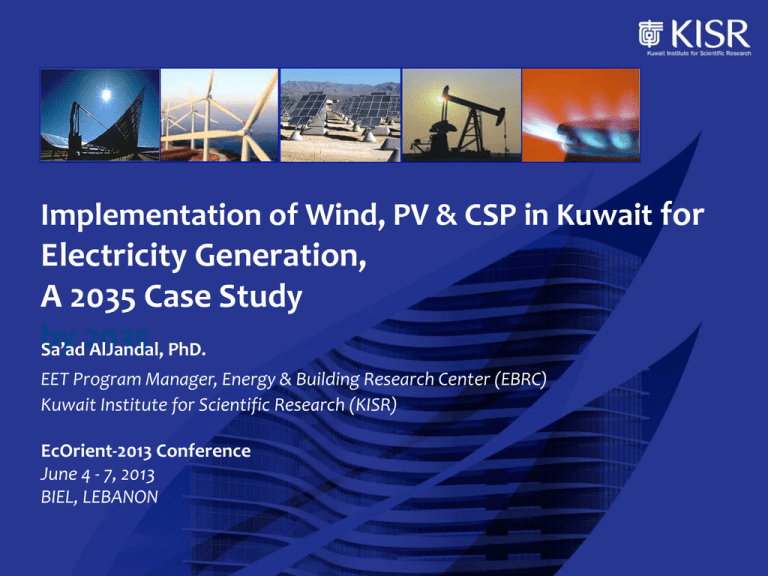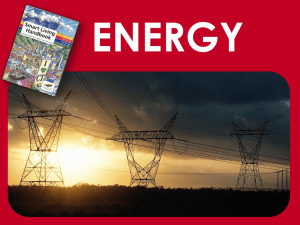Implementation of Wind, PV & CSP in Kuwait for Electricity
advertisement

Implementation of Wind, PV & CSP in Kuwait for Electricity Generation, A 2035 Case Study by Sa’ad2035 AlJandal, PhD. EET Program Manager, Energy & Building Research Center (EBRC) Kuwait Institute for Scientific Research (KISR) EcOrient-2013 Conference June 4 - 7, 2013 BIEL, LEBANON Implementation of Wind, PV & CSP in Kuwait for Electricity Generation, A 2035 Case Study Presentation Outline Background Energy System: Overview Motivations for Adopting RE Systems in Kuwait Simplified RES of the KISR Power and Water Model (KPW) Electricity Generation Options in Kuwait Optimum Generation Mix Inventory Kuwait RE Current and Future Projects & Challenges for RE 2 Country Background Area: 17,818 km2 Population: 3.5 million distributed within 6% of total area. Population growth rate 5.9%. Weather: Hot dry dusty summer, warm/cool with some rain in winter. Economy: In 2012, nominal GDP $195 billion . About 95% of revenue comes from oil export. Energy: Indigenous energy sources are oil and natural gas (mostly associated) 3 Current Kuwait Energy Mix & Distributions 4 Reference Energy System Distribution Primary End Energy Resources Exploration & Production (Oil & LNG) Start Power Stations & Oil Refineries Energy Conversion Energy Users End-Users Sectors, (Electricity & Gas) Mainstream 5 The Motivation Today’s pattern and trends in overall demand and supply equations are not sustainable. Make use of the inherent benefits of efficiency and alternative technologies, through the intergradations of clean strategies. Meeting high demand for electricity (Adaption). Reducing or preventing high emission rates (Mitigation). Meeting high demand from new resource (Diversification). The Expectation A portfolio of special programs to achieve sustainable targets. End-use efficiency. Sizable share of renewable / alternative technologies. Or a combination with each other. 6 The Prospects Potentials Can be a significant from the energy security point of view; Slow the growth of energy demand. promoting clean economic development. Reduce emissions. Assuming that; RE would reach its full potential in the next 20 to 50 years; RE could replace fossil-fuel peak power generation up to 20% by 2030. RE could curb energy-related global CO2 emissions concentrations by up to one third by 2050 (compared with a BAU case). 7 The Objectives 1. A general assessment of the status on present & projected supply (oil & gas) resources, energy demand forecasts, (P&W capacities, fuel consumption) & identify the potential supporting measures driving this evolution. 2. A feasibility study of future RE technology options to forecast the trends of technology development, its characterizations & the economics of contribution in implementing these technologies. 3. An assessment, through a methodology, the impact of introducing RE on the potential financial gains & land-use, as part of the country’s energy supply mix. 8 Simplified RES of the KISR Power and Water Model (KPW) PRIMARY ENERGY SUPPLY CONVERSION TECHNOLOGIES (PRIMARY ENERGY) Domestic Crude oil Natural gas Heavy fuel oil Gas-oil Renewables Imported Natural gas Nuclear PROJECTED DEMAND FOR ELECTRICITY and WATER (FINAL ENERGY) Existing Power and Desalination Plants NRH SPP NRH SPP + MSF OCGT CCGT CCGT + MSF RHSPP + MSF Aggregated Electricity and Water Demands covering • Industry • Commercial buildings • Government buildings and services • Residential buildings New Power and Desalination Plants Nuclear CCGT (Natural gas) RHSPP (Heavy fuel oil) + MSF + RO Renewable Energy Plants Solar Thermal PV central and distributed Solar cooling Wind Solar water desalination 9 Kuwait RE Scenario Development and Analysis (2010-2035) Acronym Description REF A policy scenario based on historical fossil fuel development until 2008; fossil fuel demand kept constant after 2008; used as reference simulation to which alternative fossil fuel scenarios following KPC “reference” assumptions are compared for their impact. REF-RE10 A target scenario that assumes REF technologies within the portfolio of future power plants to identify the cost-effective penetration of RE options that ramps-up from zero share in 2013 to the cost-effective share in 2030. (Suffix: RE10 is for 10% contribution from RE technologies). REF-RE20 A target scenario that assumes REF technologies within the portfolio of future power plants to identify the cost-effective penetration of RE options that ramps-up from zero share in 2013 to the cost-effective share in 2030. (Suffix: RE20 is for 20% contribution from RE technologies). REF-ff A policy scenario based on REF; used as reference simulation to which a minimum fuel utilization constraint is placed on power plants as 60% for existing, 50% for new and 10% peaking. on are compared for their impact on the system. For existing and new plants the minimum constraint is relaxed to 20% with RE. (Suffix: ff is for flexible fossil operation). 10 Key Input Parameters Electricity Profile Hourly Load Curves for 2008 & 2009 Resource Supply Base & Expansion Cases Resource Costs KEC Price Projections Fuel oil, Diesel & Natural gas price ratios Model Horizon 2008 Base Year to 2050 with focus on 2010 -2030 MARKAL TIMES-VEDA KPW Model Final Energy (Power & Water) Demand Projections MEW, Low & Lower Future Power Sector Technologies Renewables, Nuclear, CCGT & RHSPP Existing Power Sector Plants Size, age, fuel type, efficiency, O&M costs, fuel costs, availability, decommissioning date, etc. for power and desalination plants 11 Viable options for Electricity Generation Technology LCOE ($/MWh) 2015 2030 Combined Cycle Gas Turbine (CCGT) 97 125 CCGT/Multi-Stage Flash 118 159 Reheat Steam Turbine 160 175 Solar CSP Trough 198 144 Solar CSP Trough + 6 hrs storage 293 217 Solar CSP Trough + 10 hrs storage 212 154 Solar PV Central 165 91 Solar PV Distributed 177 99 Wind 106 82 12 28.0 Demand Electric load (GW) 26.0 24.0 22.0 20.0 18.0 16.0 14.0 12.0 10.0 2010 30 2015 Supply: Reference Case 2020 2025 2030 Year 40 900 850 800 750 700 650 600 550 500 450 400 2035 Water (MIGD) Optimum Mix Inventory for Electricity Generation Water demand Supply: Opt. Mix Case Solar PV 35 25 Electric peak load 30 Wind 25 Liquied fuel based technology 15 10 Gas fuel based technology 5 0 2015 2025 Year 2035 GW GW 20 20 Solar thermal 15 10 Liquied fuel based technology 5 2015 2025 Year 2035 Gas fuel 13 based technology Main Results by 2035 Issue Case Reference Opt. Mix Total installed capacity of Gas/liquid systems (GW) 27 23 Total installed capacity of RE systems (GW) 0 11 131 / 100 92.7 / 72 0 35.9 / 28 Required oil equivalent fuel (million barrel) 170 131 CO2 emission (million ton) 70 55 Total discounted cost up to 2035 (billion US Dollar) 188 183 Gas & liquid systems contribution (TWh / per cent) RE contribution (TWh / per cent) 14 Kuwait RE Current and Future Projects Research and Development & Demonstration Programs at KISR • RE R&D Demons. Park (Wind, CSP, PV Cent. and Striling Dish) , 70 MW (part of 2000 MW by 2035) • BIPV in new Administration / Centers Buildings, 1 MW • PV Car Parking Shades with grid connection, 0.5 MW • Thermal & PV Solar Simulators and Materials testing facilities, 15 labs at KISR (EBRC) Government Sector • BIPV & Rooftop in 100 school Buildings (MoEd.), 1 MW • BIPV & PV Car Shades with Grid connected twin Buildings (MEW & MPW), I MW each • Integrated Solar Combined Cycle (ISCC) & Gas Power Station (MEW), 280 MW Commercial Sector • BIPV & Rooftop in new Buildings (KPI), 1 MW • Rooftop PV on Residential (500 Houses) and Super Markets. • BIPV & PV Car Shades with Grid connected Petrol Stations (KNPC), I MW • PV for Remote oil & Gas fields various installations (KOC), 30 MW • PV & Solar Thermal installations (Pan Arab & PAAET), up to 10 MW 15 Challenges for Renewable Energy Resource and Power System Integration • Intermittency, Variability & Capacity credit • Transmission Availability & Access • Infrastructure & Building Requirements • Materials & Resources Commercialization • Technology Development, World’s Tech. / Manufacturing Forecasts • Policy and Regulatory Requirements, codes & regulations • Long-term Integration Targets, Government and investors • Government Funding loan , Subsidies, Tax-Credits & Feed-in Tariffs …etc. • Human Resources & Training Environmental Impact • Renewable Energy Footprint Assessments, LCA • Land –Use, Size & Availability 16 Thank You








